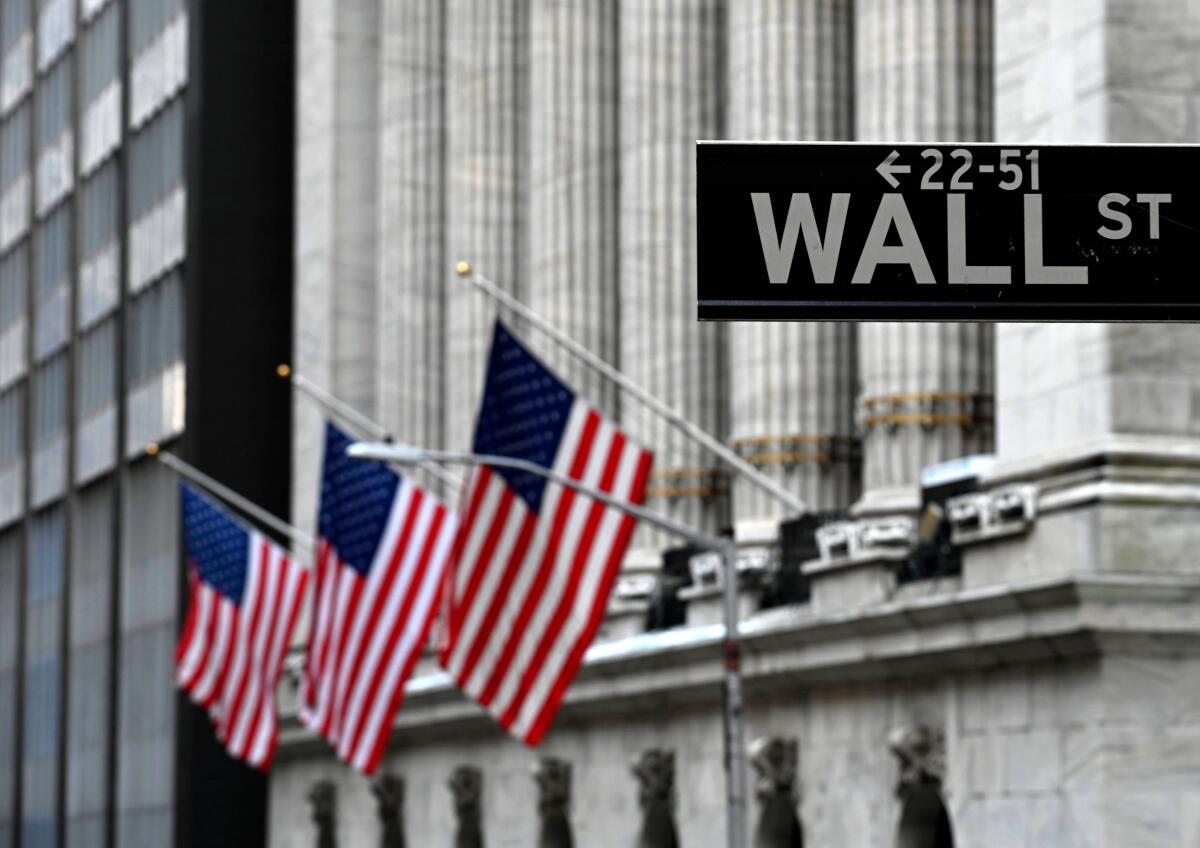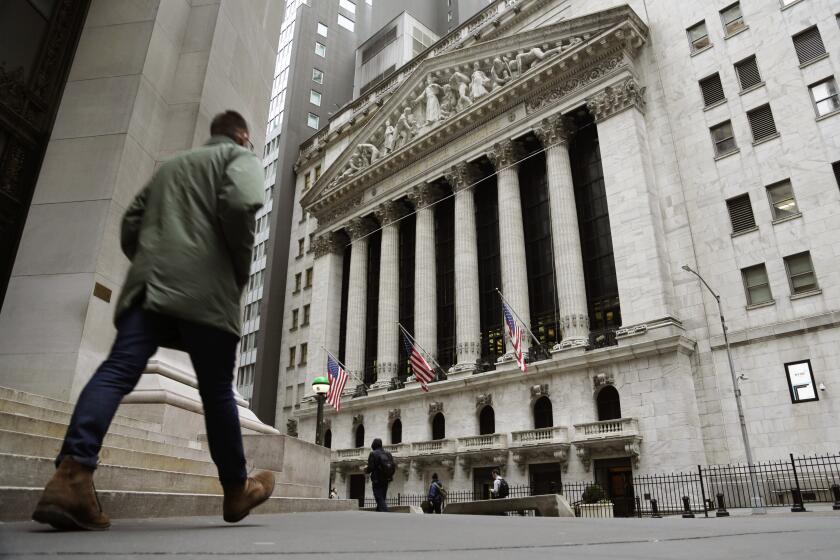Legendary investment guru Peter Lynch says the move to index funds is a ‘mistake.’ He’s wrong

- Share via
The least surprising financial news nugget in recent days may have been this one from a Bloomberg interview with Peter Lynch, one of the most venerated stock market gurus of our time.
Lynch, 77, told Bloomberg that the wholesale move of investors in recent decades from actively managed mutual funds to passive investing — that is, index funds — is “a mistake.”
He said, “Our active guys have beat the market for 10, 20, 30 years, and I think they’ll keep on doing it.”
The index fund was at first ridiculed, then tolerated, then grudgingly accepted, then reluctantly endorsed, and finally copied en masse.
— Jack Bogle, inventor of the index fund at Vanguard
On Wall Street, this is known as talking one’s book. Lynch, of course, was the quintessential active investment manager, renowned for his stock-picking skills. Fidelity Magellan Fund, the mutual fund he ran from 1977 to 1990, was the quintessential actively managed mutual fund.
By giving Magellan investors an annualized return of more than 29% — compared with an annualized gain in the Standard & Poor’s 500 index of about 15% during the same period — Lynch grew Magellan’s assets under management from $18 million to $14 billion, making it the largest mutual fund in the world.
Get the latest from Michael Hiltzik
Commentary on economics and more from a Pulitzer Prize winner.
You may occasionally receive promotional content from the Los Angeles Times.
Magellan lost that crown in 2000 to Vanguard’s S&P Index Fund, the quintessential passively managed mutual fund.
Lynch’s remarks play into the enduring debate about which is better for investors, active management or passive, and under what circumstances.
If his remarks are taken as advice at face value, then they’re a disservice to the average retail investor.
That’s because the debate has long since been resolved by reality: Active investment managers consistently fail to match or exceed the benchmark indices of their funds. Passively managed index funds, by definition, always hit their benchmarks.
More than 57% of all U.S. domestic stock funds underperformed their benchmarks in 2020, according to the latest S&P Indices Versus Active scorecard, known as SPIVA.
In some categories, the record was even worse: About 60% of all large-capitalization mutual funds failed to match the S&P 500 index, and more than 80% of midsized core mutual funds fell short of the S&P MidCap 400 index.
The record isn’t any less dismal over longer periods. More than 67% of actively managed U.S. equity funds underperformed the S&P Composite 1500 index, which comprises 90% of all U.S. publicly traded companies, over three years; 72.8% of funds fell short over five years, 83.2% fell short over 10 years and 86% over 20 years.
A cryptocurrency company thinks it will get a boost from putting its name on the Lakers’ arena. History begs to differ.
It’s proper to note that Lynch probably didn’t set out to offer investment advice. His remarks to Bloomberg came chiefly in connection with the announcement of a donation of $20 million in artworks to his alma mater, Boston College. Pressed to comment further on the record of active vs. passive management, he said, “I don’t keep score. I’ve got 10 grandchildren. ... That’s what I keep score on.”
But he also pointed to the performance of three Fidelity fund managers to validate his general claim that active beats passive.
It’s true that his three exemplars have done well, but many of Fidelity’s actively managed funds have not met their benchmarks. That includes Magellan, on an after-tax basis — an annualized gain of 15.3% over 10 years, after taxes on distributions, versus the S&P 500’s average gain of 16.63% per year.
So it’s proper to take a closer look at Lynch’s viewpoint and its context.
First, some fundamentals. Traditionally, stock mutual funds were operated by investment managers who aimed to find the best values in the equity markets, traded actively to capture gains and dump their dogs, and collected healthy fees for their efforts.
Column: Biden takes aim at the multitude of ways that businesses can make your life miserable
Baggage fees, drug prices, net neutrality — Biden aims to reduce industry’s control of your daily life.
That model was upended in 1976 by John C. Bogle, who introduced the first index fund at Vanguard, which he founded. Bogle felt that the best way to serve small investors was to offer them low-cost funds tied to broad market indices.
Because they had to match the indices’ baskets, which seldom change, they would do relatively little trading and thus would incur few tax liabilities, which only get passed on to investors. They required “no management whatsoever,” at least in terms of stock-picking, Bogle recounted years later.
That first fund, keyed to the S&P 500 index, was denigrated as “Bogle’s Folly.” As he recollected, “the index fund was at first ridiculed, then tolerated, then grudgingly accepted, then reluctantly endorsed, and finally copied en masse. It has changed how we think about investing.”
Today there’s scarcely a mutual fund firm that doesn’t include a galaxy of index funds among its offerings. (To be sure, while mostly identified as an index fund family, Vanguard also offers actively managed funds.) Passive management comprises about 43% of U.S.-based mutual fund and exchange traded funds, or $10 trillion, today, compared with about 31.6%, or $4.1 trillion, in 2015.
Several factors contribute to the superior performance of index funds. One is the sheer difficulty of consistently beating an average return year after year. From time to time, managers will emerge who do so for a stretch of time, but like baseball players on a tear, eventually almost all go cold.
Has any era given birth to more dubious investment mechanisms than today?
Index funds tend to be tax-efficient. By trading relatively rarely, they minimize the realizing of capital gains; these are distributed to their investors, who must pay taxes on them every year.
The taxable distributions of Vanguard’s S&P 500 index fund in the first two quarters of this year came to about .65% per share; Magellan’s last capital gain distribution in May was the equivalent of 4.75% of its share price.
Index funds’ management fees are also generally minimal compared with those of actively managed funds. The expanse ratio of the Vanguard 500 stock fund is 0.04%; Fidelity Magellan’s is .79%.
Lynch brought a sober rationality to stock selection. He abjured the hunt for home runs, but his on-base percentage was high. He looked for companies likely to experience steady growth yet underpriced by the market. He scrapped losers and held on to winners, and set little store by market or economic forecasting, since such predictions were inevitably based on a heavy helping of guesswork.
Lynch is one of the very few investment managers to notch a superior performance over more than a decade, which earned him the label of stock-picking greatest of all time from financial commentator and manager Barry Ritholtz, whose judgment counts for a lot. (Lynch told Ritholtz he would award that crown to Warren Buffett.)
But even Magellan failed to match the S&P 500 in two of Lynch’s 13 years at the helm, though he never had a down year; the S&P 500 had two negative years during his tenure.
The GameStop frenzy recalls stock market manias of the past. They all end in tears.
After Lynch’s departure, Magellan came well back down to Earth, underperforming the S&P 500 in 15 years from 1980 through 2020. It’s destined to fall short again this year, with a one-year gain of 22.8% through Sept. 30, against a 30% gain in the S&P 500. From a peak of about $110 billion in assets around the turn of this century, Magellan is now down to about $31 billion.
Indexing isn’t without its critics. Many focus on its overall effect on the market and the broader economy, as it has taken over the investment landscape.
One concern is with the sheer size of the passive category. One fund alone, the Vanguard Total Stock Market Index Fund, has nearly $1.3 trillion under management, accounting for 10% of all assets in U.S. stock funds and ETFs. (Disclosure: I own shares in the index fund and in its related ETF.)
This leads to concerns that passive investors and their managers have no incentive — indeed, little ability — to leverage their shareholdings to influence corporate behavior.
As it happens, the rise of passive investing has given the passive mutual fund companies dramatically more power, if they were to choose to exercise it. The top three index fund firms, BlackRock, Vanguard and State Street, hold a combined 22% of the shares of the average S&P 500 company.
If the three firms voted as a bloc, they could change corporate behavior in significant ways. Thus far, they haven’t done much jawboning, either together or individually.
The big index funds have been too passive on issues such as global warming, for example. Former Vice President Al Gore raised that issue in a 2019 interview with the Financial Times. “The large passive managers have a real difficult decision to make,” he said. “Do they want to continue to finance the destruction of human civilization, or not? Their model makes it difficult for them to execute some of the strategies that active managers have available to them.”
BlackRock Chairman Laurence D. Fink has been outspoken about the responsibility of corporate managements to act in socially beneficial ways, but his prescriptions may not entirely sit well with social and economic activists. Earlier this year, for instance, he came out against the movement to divest fossil fuel companies from investment portfolios. Better, he said, to try to influence those companies from the inside.
It’s certainly true that broad indexing saps investors of their ability to be as discerning as they may wish about what companies they want to own. Object to tobacco companies? As an S&P 500 index holder, tough: five tobacco companies are in the index. Want to shun oil and gas? An S&P 500 index fund has to own 25 fossil fuel companies.
Investment firms have responded by offering index funds sliced and diced to appeal to more discriminating investors. The concept is “direct indexing,” which allows customers to pick and choose among the stocks in an index to create, essentially, their own index. Yet this tends to defeat the purpose of index investing by returning to active stock-picking.
Lynch, in his comments this week, didn’t seem to be alluding to any of these tangential issues with passive investing; his claim was that active stock-picking beats the market, which simply isn’t true. For much of the nearly half-century in which index funds have been an option for the average investor, they’ve been the way to go.
It’s commonly said on Wall Street that past performance is no guarantee of future results. But that applies most accurately to individual investments. As a class, the record of index investing in the past is indisputable.
More to Read
Get the latest from Michael Hiltzik
Commentary on economics and more from a Pulitzer Prize winner.
You may occasionally receive promotional content from the Los Angeles Times.















